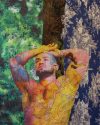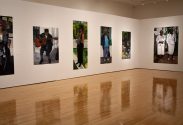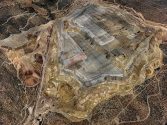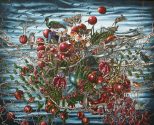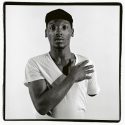“Cut from the Same Cloth: Tim Hailand at Arthur Roger Gallery,” Pelican Bomb
The term Toile de Jouy refers to a particular style of patterned textile, typically a neutral background overlaid with woodcut-style bucolic scenes of Rococo romance. Think of men and women lounging in billowed, ruffled sleeves, children playing in pantaloons, a musician playing the flute, or a farm animal at work. Roughly translated, Toile de Jouy means “canvas of joy.” Considering these designs were often made into upholstery or wallpaper, the average contemporary viewer may be hard-pressed to feel joy; to be thrilled by a seat cushion or a parlor wall would be a rare ecstasy. However, artist Tim Hailand seems to be after something more complex than simple joy in his exhibition “Sister I’m a Poet,” currently on view at Arthur Roger Gallery.
